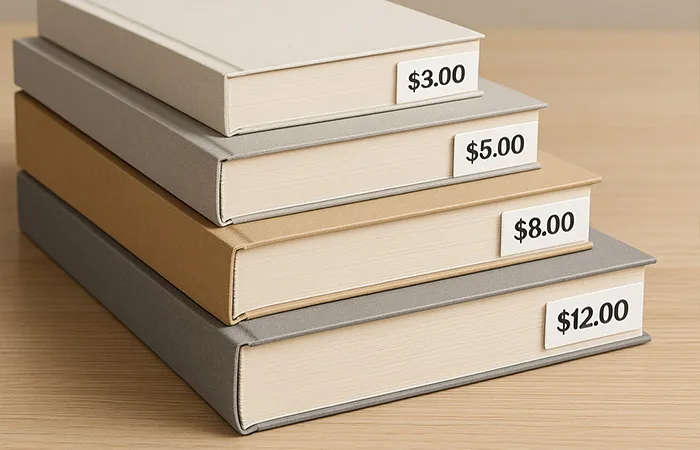
Printing a high-quality book doesn't have to be expensive. Whether you’re self-publishing a novel, creating an art catalogue, or launching an educational manual, smart decisions during the design and production stages can significantly reduce your costs—without sacrificing print quality or reader experience. Below are essential techniques to keep your budget under control while maintaining professional standards.
Cheap doesn’t have to mean low quality. By understanding how printing costs are structured, you can make informed choices about format, paper, colours, and finish. These smart decisions can free up your budget for better distribution, cover design, or additional content—without cutting corners where it really matters.
Black and White Printing: When Is It Enough?
Colour printing can significantly increase your overall costs—especially on large print runs or content-heavy documents. In many cases, black and white printing is more than sufficient, particularly for novels, reports, manuals, and academic texts. Reserve colour for essential pages, such as the cover or specific charts and illustrations. Monochrome layouts can still look professional when paired with good typography and paper choice, helping you deliver quality at a lower price.
Reducing Paper Waste Through Smart Layout Design
Efficient layout design plays a key role in minimising paper waste and trimming your printing budget. Use standard sizes like A5 or A4 and plan your page count in multiples of 4 or 8 to avoid empty or unused pages. Consider two-column layouts to make better use of space in text-heavy content, and avoid excessive white margins. Smart imposition helps your printer use each sheet efficiently, resulting in less waste and lower costs.
How Paper Weight Impacts Cost and Perception
Heavier paper stocks give a premium feel—but they also increase costs and shipping weight. For most book interiors, 80–100 gsm is sufficient and widely accepted, while covers may use 250–300 gsm for better durability. Choosing the right paper weight can help you strike a balance between professional look and budget. Ask for samples to compare thickness, opacity, and finish before finalising your choice.
Print Only What You Need: Calculating Run Size Wisely
Overestimating print quantities leads to unnecessary expenses and storage issues. Underestimating can result in reprint fees. The solution is to carefully estimate your audience or distribution needs. Consider printing in smaller batches or on demand, especially for first-time publications or self-published books. Many printers offer sliding scale pricing—so comparing unit costs across run sizes can help you make smarter decisions.
Proofing Before Printing: Catching Errors Early
Spotting layout errors or typos after printing can be costly. Always request a digital or physical proof before approving your final run. Review bleed settings, margins, image quality, page order, and embedded fonts. It's also wise to have a second person review the file. Proofing ensures your file is ready for press and helps you avoid expensive mistakes that could require a full reprint.
Economical Printing for Schools, NGOs, and Self-Publishers
Budget-conscious organisations often face unique constraints. Schools, charities, and independent authors can save by using lightweight paper, black and white interiors, and simple bindings like saddle stitching. Opt for standard formats, avoid luxury finishes, and keep page counts efficient. If you're part of a non-profit, ask your printer if they offer discounts or flexible payment options for educational or community-focused projects.
Print in Batches: Managing Inventory and Cash Flow
Printing in smaller batches allows you to reduce upfront costs and manage stock levels efficiently. Instead of investing in 1,000 copies at once, consider ordering 300–500 copies and reprinting as needed. This approach reduces storage space, avoids waste, and keeps your cash flow flexible. It also gives you time to test market demand before committing to large print runs.
Digital or Offset: Which Is More Cost-Effective?
Digital printing is often cheaper for small runs (under 300 copies) and offers quick turnaround. For larger runs, offset printing provides a lower cost per unit, especially when using standard paper and formats. Ask your printer to calculate both options based on your exact quantity to identify the best value.
How to Save on Shipping Costs
Shipping is often overlooked, but it can eat into your budget quickly. Choose lightweight paper, avoid oversized formats, and print as close as possible to your delivery destination. If you're distributing across Europe, for example, printing in Europe could be more cost-effective than shipping from abroad.
Can You Cut Design Costs Too?
Design can represent a significant part of your print budget—but there are smart ways to reduce costs without affecting the final quality. Using standard formats (like A5 or A4), working with minimalist layouts, and reusing existing visuals can all help streamline the process. Avoid overly complex graphics or formats that require heavy retouching.
To make things easier, we offer affordable layout services tailored to your budget. Whether you need a simple book layout, corrections on an existing file, or full document creation from scratch, our team can help. We’ll make sure your file meets professional printing standards—correct bleeds, safe margins, embedded fonts, CMYK colours—so you avoid costly production issues or reprints.
Saving on design doesn’t mean cutting corners. It means making smart, efficient choices—and getting expert support where it matters most.
Need Help?
We can advise you on the most economical solutions for your next book project. Whether you're looking to lower the cost per unit, simplify your format, or plan a small print run, request a quote and we’ll guide you step by step.